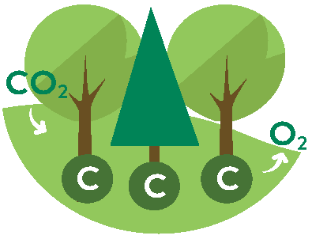There are many methods and solutions being proposed on how carbon dioxide can be efficiently and properly sequestered from our atmosphere, and there is an extremely simple way to go about this: planting more trees! Forestation is the broad term for describing the process of growing forests on barren land. There are other types of forestations, such as:

- Forest Restoration – the process of restoring a forest in its structure and biodiversity
- Reforestation – includes planting trees and allowing them to regrow on land that was recently a forest
- Afforestation – involves starting and growing a forest on land that has not been recently covered by forests
Trees are able to store carbon for long periods of time, and this process starts and continues as they grow. Through photosynthesis, they’re able to contribute to the sequestration of one-third of global emissions alongside other types of vegetation. Trees can trap CO2 from the air and store it in their wood, bark, leaves, and roots. When trees combine and create forests, they can store up to 1.6 to 33 tons of carbon dioxide per year in a single hectare. When trees are chopped down to be used as a natural resource, they keep the carbon dioxide trapped and trees can also help the environment even when they’re gone.
While these methods of forestation can contribute to carbon removal, they also have other benefits including building an ecosystem. Forests provide homes and habitats to a large number of species and enhance biodiversity. In addition, reforestation can also improve the quality of its surroundings – in the air, water, as well as soil.

Throughout this post we have discussed the positive contributions of mass growing trees, but why hasn’t it been implemented yet? They’re the easiest and cheapest way of removing carbon from the air, but, as with all environmental solutions, they have trade-offs. While we are saving resources and money through this method, we do not have enough land to do so. We are in the middle of modernizing and technological advancement, so we do not have the land to spare to make room for planting trees.
This now leads us to another possible solution that environmentalists and economists have proposed: prevent deforestation. In order to advance our country and its progress, people have been cutting down trees and using the land for buildings and renovation. However, if we were to make do with what we have now and keep the forests as they are, we wouldn’t be burying ourselves further into the climate crisis. While this may sound easy, not everyone is on board and has been thinking of ways to be able to remove carbon as well as being allowed to progress in civilization.
We’ve all learned since elementary schools that trees are good for the environment, so I think it makes sense that we should plant more. For Earth Day one year in my elementary school, they gave all the students a dogwood tree sapling. I went home and planted it in my yard, but apparently the weed person thought it was a weed and pulled it out. I always wonder what could have happened if that tree continued to grow. I also remember that recently there was a Team Trees movement that tried to plant 1 tree for every 1 dollar donated, so I wonder how that went.
Well forestation sounds like a great idea, unless population starts to decrease, it will never come to fruition. We will keep expanding and taking the forest with us, unless we make polices to stop it. I think there is a balance between keeping forests that we have already, while also introducing carbon scrubbers through pollution heavy area. However, we really won’t know until it happens, so until then we should keep the trees in the front of our mind!